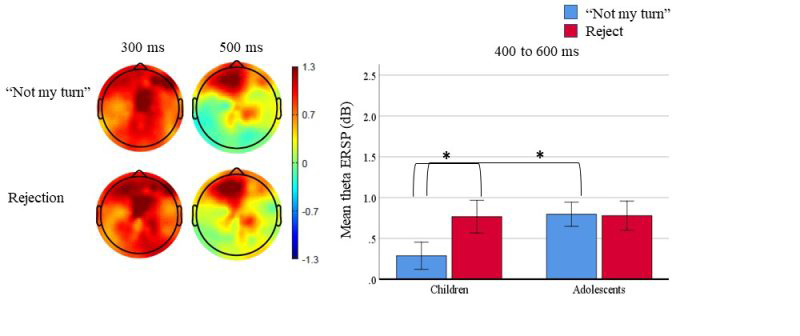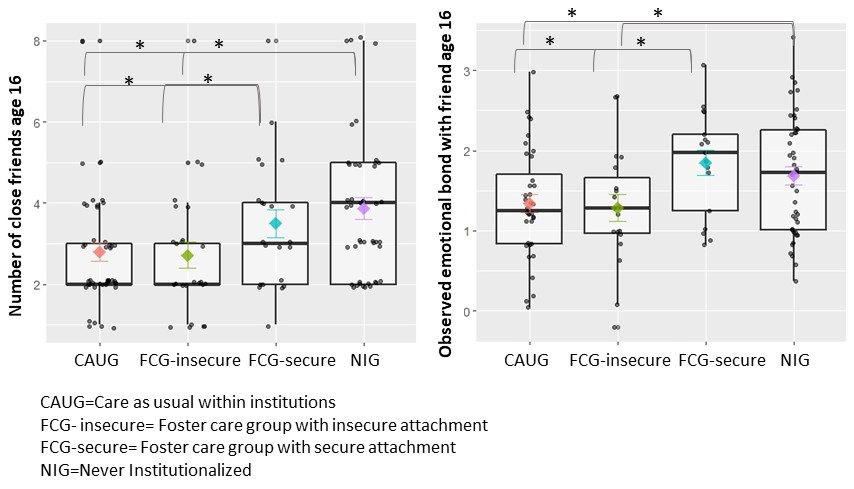See current studies for our current work and opportunities to participate.
Several areas of research in our expertise are featured below.
Developmental and individual differences in processing social information
Adaptive social information processing helps youth adjust their social behaviors and thrive in the peer context, whereas maladaptive processing could have downstream effects on psychopathology and poor social functioning. We have used electrophysiology (EEG, ECG) in experimental tasks to understand how typically developing children and adolescents process social situations, such as social exclusion and social evaluations. Our work has shown a normative developmental pattern, in which adolescents show heightened sensitivity in the brain to social exclusion events compared to children. Additionally, this heightened neural sensitivity to social exclusion emerges earlier in children who are more shy, and who might have similar social fears as adolescents. We also used an atypical development model to examine consequences of maladaptive processing in a separate study of adolescents who experienced severe neglect due to being raised in an orphanage. Adolescents with a history of neglect reported less negative emotions and showed dampened physiological responses when receiving social rejection feedback, which were related to more peer problems at follow-up.

Lifespan development of temperament and developmental processes
Temperament refers to the behavioral and emotional differences observed in children early in life. Temperaments influence how we think, feel, and interact with others. The temperaments that we study the most are called behavioral inhibition and shyness. Our work in collaboration with the University of Maryland using longitudinal studies that follow young children into adulthood have elucidated the lasting influence of an inhibited infant temperament on personality, social functioning, and psychopathology, including anxiety and depression in adulthood. Recently, we tested a health-behavior hypothesis and found that shy-avoidant children have higher cardiovascular and metabolic risks by adulthood, because they were less physically active as adolescents (measured by accelerometers). While temperamental biases toward vulnerability for health problems exist, these relations are not deterministic. Not all shy children grow up to have health problems; Many shy children grow up into healthy productive adults. We have shown that children can grow out of their shyness over time, and various neurocognitive processes (e.g., inhibitory control, reward processing) and positive peer experiences can change shy children’s adverse trajectories.

Early adverse experiences, development, and pathways of risk and resilience
We have studied the effects of various early adverse experiences (e.g., child maltreatment, neglect, and parent-child separation) on the development of the brain, relationships, and cardiometabolic health through collaborations with the Bucharest Early Intervention Project, the only randomized controlled trial to evaluate the effects of an early foster care intervention among abandoned infants from Romania, and past connections with Child Protective Services and the Department of Child and Family Services.
One of the primary goals of this research is to identify risk and resilience mechanisms and processes that can inform prevention strategies and social policy. For example, our work on the development of cardiometabolic risks among adolescents with a history of neglect has tested several developmental models to outline risk modifiers, including stressful life events, behavioral problems, and accelerated early weight gain after removal from an environment with restricted growth, that prevention programs could target. Currently in the U.S., hundreds of thousands of foster care children move into multiple foster homes in their life time (this number could be in the double digits) and the quality of foster parents vary. Our work has suggested the importance of implementing policies to ensure stable foster care placements and training of high-quality foster parents that enhance child-caregiver attachment relationships, which are essential for optimal long-term social and brain development.

